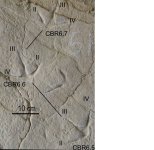albertonykus
Well-known member
Herrero, C., E. Herrero, J. Martín‑Chivelet, and F. Pérez‑Lorente (2023)
Avian ichnofauna from Sierra de las Cabras tracksite (late Miocene, Jumilla, SE Spain)
Journal of Iberian Geology (advance online publication)
doi: 10.1007/s41513-023-00205-x
The Sierra de las Cabras (Lat. 38° 28′ 53″N, Lon. 1° 24′ 52″W) is an exceptional ichnofossil site of late Miocene age, located in the Prebetic ranges near the town of Jumilla (Murcia Province, SE Spain). The site contains abundant vertebrate ichnofauna preserved in carbonate facies that were deposited in a semi-arid wetland system with shallow ponds and marshes. The ichnofauna includes diverse mammal footprints and trackways, which have been recently studied, as well as bird ones, which are the target of this paper. We report a total of 51 avian footprints spread over two of the three track-bearing stratigraphic surfaces of the site. The detailed study of these ichnites (footprints and trackways) allows their attribution to the ichnogenus Fuscinapeda (Sarjeant and Langston, Texas Memorial Museum Bulletin 36:1–86, 1994), as well as to infer diverse patterns of bird’s behavior consistent with shallow water wetlands avifauna. Also, we discuss about the possible trackmakers, which should correspond to walking birds characterized by long legs, with no hallux or a raised one, which could probably belong to the Gruiformes order. The study confirms the presence of Fuscinapeda in the Iberian Peninsula and completes the characterization of the vertebrate ichnofauna of Sierra de las Cabras, a site that joins the nearby Hoya de la Sima ichnofossil site to yield the largest and most diverse record of vertebrate ichnites of late Miocene age in southern Iberia.
Avian ichnofauna from Sierra de las Cabras tracksite (late Miocene, Jumilla, SE Spain)
Journal of Iberian Geology (advance online publication)
doi: 10.1007/s41513-023-00205-x
The Sierra de las Cabras (Lat. 38° 28′ 53″N, Lon. 1° 24′ 52″W) is an exceptional ichnofossil site of late Miocene age, located in the Prebetic ranges near the town of Jumilla (Murcia Province, SE Spain). The site contains abundant vertebrate ichnofauna preserved in carbonate facies that were deposited in a semi-arid wetland system with shallow ponds and marshes. The ichnofauna includes diverse mammal footprints and trackways, which have been recently studied, as well as bird ones, which are the target of this paper. We report a total of 51 avian footprints spread over two of the three track-bearing stratigraphic surfaces of the site. The detailed study of these ichnites (footprints and trackways) allows their attribution to the ichnogenus Fuscinapeda (Sarjeant and Langston, Texas Memorial Museum Bulletin 36:1–86, 1994), as well as to infer diverse patterns of bird’s behavior consistent with shallow water wetlands avifauna. Also, we discuss about the possible trackmakers, which should correspond to walking birds characterized by long legs, with no hallux or a raised one, which could probably belong to the Gruiformes order. The study confirms the presence of Fuscinapeda in the Iberian Peninsula and completes the characterization of the vertebrate ichnofauna of Sierra de las Cabras, a site that joins the nearby Hoya de la Sima ichnofossil site to yield the largest and most diverse record of vertebrate ichnites of late Miocene age in southern Iberia.





